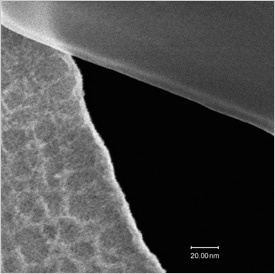Nov 21 2008
Carl Zeiss SMT has set a new record resolution benchmark for scanning electron and ion microscopy - pushing scanning beam technologies beyond its current limits. By employing ZEISS' revolutionary ORION® Helium- ion microscope, a surface resolution of 2.4 Angström (0.24 Nanometer) has repeatedly been achieved (25%-75% edge-rise criterion) on various samples. This resolution - which is close to the diameter of a single atom - is three times better than even the most sophisticated scanning electron microscopes are able to achieve today with the same surface sensitivity. It sets the new benchmark for surface imaging in the subnanometer range. Existing customers will obtain the possiblity to upgrade their systems to this performance level.
 For demonstration of the image resolution of 0.24 Nanometers a linescan over the very sharp edge of an asbestos fiber on a thin holey carbon foil is shown. The texture of the holey carbon foil demonstrates the extremely high surface sensitivity of the ORION® which equals or even exceeds the surface sensitivity of an SEM operated at 1kV and below.
For demonstration of the image resolution of 0.24 Nanometers a linescan over the very sharp edge of an asbestos fiber on a thin holey carbon foil is shown. The texture of the holey carbon foil demonstrates the extremely high surface sensitivity of the ORION® which equals or even exceeds the surface sensitivity of an SEM operated at 1kV and below.
Dr. Nicholas P. Economou, Senior Vice President of Carl Zeiss SMT, is enthusiastic about the result: “This unmatched resolution for surface imaging with scanning electron and ion microscopes is extremely important for semiconductor manufacturers and many others who need to see small features that currently cannot be resolved.“ The ongoing shrinkage of feature sizes of semiconductor devices makes extreme high resolution microscopy mandatory. “Some layers of integrated circuits already have reached a thickness of only a few atoms”, Dr. Rainer Knippelmeyer, Senior Vice President Operations of Carl Zeiss SMT explains, “Semiconductor manufacturers are in dire need of reliable high- resolution, surface sensitive metrology and process control tools. With the ORION® Helium- ion microscope we offer exactly the tool the industry and nanotechnology research needs and we continue to keep pace with the industry’s rapidly changing requirements.”
The secret behind the extreme high resolution of the Helium-ion microscope lies in the proprietary source technology and in the interaction between the scanning ion beam and the surface of the specimen. The source of the microscope is very small and the helium ions emanate from a region as small as a single atom. Unlike electrons, the helium ions have a very small wavelength and hence do not suffer appreciably from adverse diffraction effects - a law of physics which fundamentally limits the imaging resolution of electrons. Also, the helium ion beam triggers signals directly from the surface of the sample and stays very collimated upon entering the sample. This results in very sharp and surface sensitive images at the quoted resolution which can be easily interpreted. In contrast, for a typical SEM, the majority of the secondary electrons that are used for imaging come from deeper and much less confined regions within the sample, creating blurrier images with less resolution than the ORION® Helium-ion microscope.